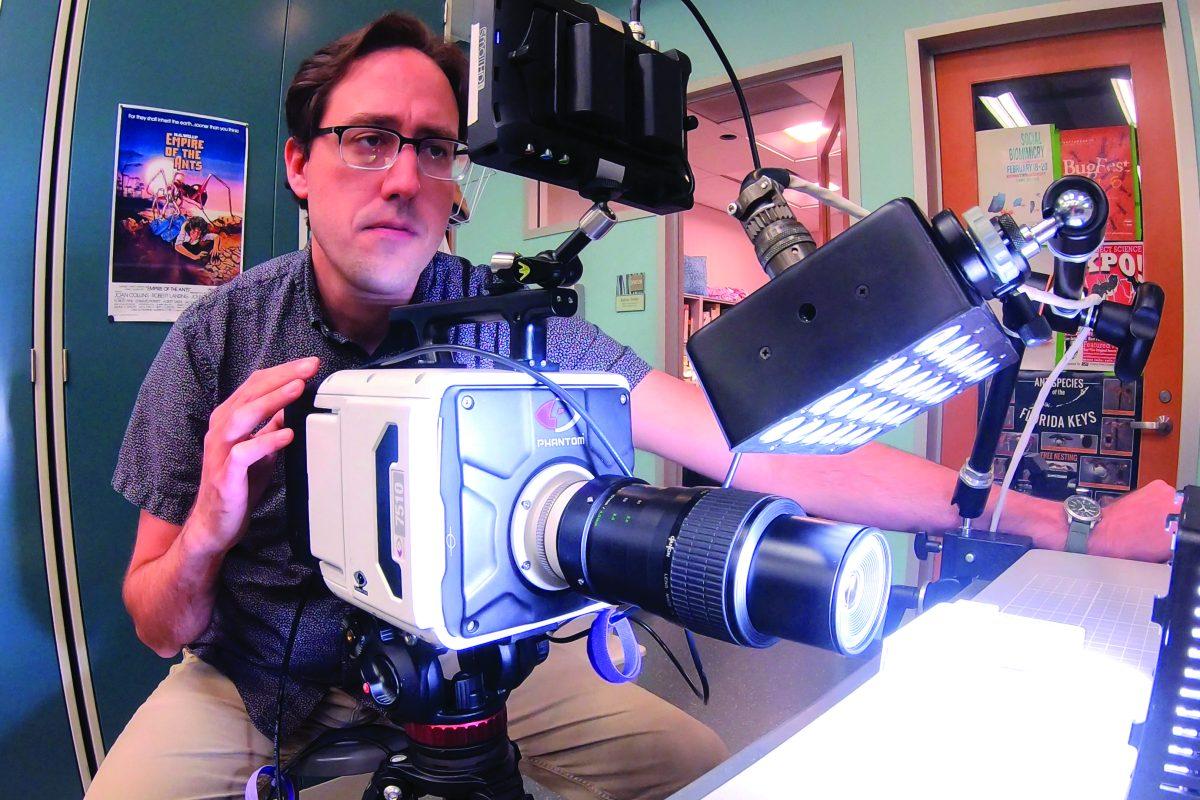Ants, spiders and cockroaches might be nuisances to most people, but for Adrian Smith, head of the Evolutionary Biology and Behavior Research Lab at the North Carolina Museum of Natural Sciences, zooming in on these miniature marvels to reveal the magic of insects is the premise of his YouTube channel, AntLab.
AntLab wasn’t always this way. Though Smith always had an interest in media, he said his experience with film began in college.
“When I was a graduate student, I secretly enrolled in a community college film school at night, first semester and learned how to edit,” Smith said. “And then I quit and just started learning on my own.”
Smith said AntLab began as a way to display his research to colleagues but evolved to display insects to the general public as well.
“I didn’t really know why to make a video beyond sharing a research story when I first started making them, and then I figured out different reasons for making a video,” Smith said. “So then it was just about filming stuff from the perspective of someone who’s a professional entomologist with a lab with all this equipment.”
Initially, Smith worked with ants, which was something he said he stumbled upon during his undergraduate experience. Although his first experience with ants wasn’t what he hoped for, he learned to find them fascinating.
“You can have a shoebox-sized [container] that’s a colony of thousands of individuals cooperating and doing a bunch of social-collective tasks together, which is really interesting to study,” Smith said. “I was fascinated once I learned you could ask questions about how insects behave, but you could also ask questions about how like societies are organized and function in the animal world.”
Today, Smith’s videos all follow two rules: They have to be unique regarding observations or stories, and he has to be in the video.
“A lot of the stuff that’s on AntLab is footage you can’t see anywhere else: we filmed it,” Smith said. “I put it out because it’s a unique thing that I think has a lasting [impact]; it doesn’t go away unless someone builds on the observation and makes it new in some other way.”
Nicolas Galvez, a fourth-year studying zoology, works alongside Smith filming bugs at the museum’s Nature Research Center. Galvez said he and Smith catch the bugs they film themselves.
“A lot of the bugs that we get Dr. Smith finds in his backyard,” Galvez said. “A lot of the bugs that I find on campus that I think are interesting, I will bring to work the next day, and then we’ll film them.”
Galvez said filming is also a science. He and Smith use a specific sealed room at the museum for filming. The focal point of the room is a platform which a camera records. They place bugs on the platform, and then turn on the lights to spur them into movement, which the camera then captures. Galvez said they alter the room for specific bugs, such as using a tank instead of a platform for water beetles.
Of course, there is more to filming bugs than just entertainment.
Galvez said filming bugs allows entomologists to see exactly how insects perform certain mechanisms.
“With these cameras that we have that can shoot up to hundreds of thousands of frames a second, we’re able to capture movements that are very, very fast that you can’t see with the naked eye,” Galvez said.
Clyde Sorenson, an alumni association distinguished undergraduate professor of entomology at NC State, said videos like Smith’s can help the everyday person see the magic of insects.
“A lot of the things that you think of as kind of everyday, humdrum kinds of occurrences, when you look at them close and you slow it down, you realize that it’s actually pretty miraculous,” Sorenson said. “It’s pretty wild how a tiny animal like a springtail can store energy in its abdomen and fling itself 30 times its body length into the air. You just don’t recognize how incredible that ability is until you get a chance to see it up close and slow.”
Alongside showing amazing behaviors to average people, Galvez said filming bugs is important in areas outside of entomology, such as spring technology.
“There are labs that are making robots that are based off of insects and arthropods, and they wouldn’t be able to do that if they didn’t know how their bodies were put together, how their legs worked,” Galvez said.
For Smith, his videos aren’t only about educating about bugs. Smith said nobody in his family is a scientist, so he was never exposed to entomology when he was young. Ultimately, he also hopes to make entomology more accessible for kids who don’t know about it as an area of study.
“I didn’t know people research ants or insects, and I didn’t know why, right?” Smith said. “And I think that’s true for a lot of people. … It’s important for me to get out my feelings about why I do what I do, and why appreciating insects for what they are is an important thing for all of us, not just for scientific purposes. It’s important for our daily interaction and outlook towards the natural world.”













